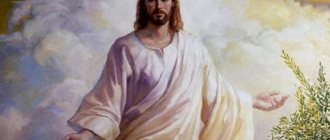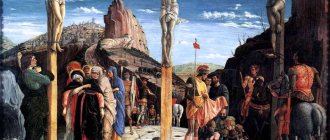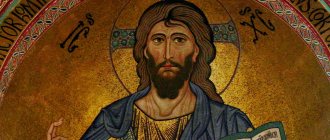Bible Questions and Answers
Published 10/15/2013
When exactly, on what day of the week, was Jesus Christ crucified according to the Bible? The Gospel of John says that Jesus was crucified on the eve of Easter, while other Evangelists say that Jesus Christ was crucified on Easter itself.
Answer:
What happened next?
In the 1st century AD, Judea was under Roman rule. All death sentences had to be “coordinated” with the Roman administration. Jesus Christ was brought to Pontius Pilate, the ruler of the province of Judea.
The ruler considered Christ innocent. But an excited crowd gathered outside his residence. Pilate did not know what to expect from the excited people. He decided to resort to the custom of releasing one of those sentenced to death on the eve of the Jewish Passover.
Pilate turned to the crowd and asked who should be released: the thief Barabbas or Christ?
“The chief priests and elders stirred up the people to ask Barabbas and to destroy Jesus. Then the governor asked them: which of the two do you want me to release to you? They said: Barabbas. Pilate says to them: What will I do to Jesus, who is called Christ? Everyone tells him: let him be crucified. The ruler said: what evil has He done? But they shouted even more loudly: let him be crucified,” writes Evangelist Matthew.
Pilate sent Christ to execution, writes “Thomas”. The Roman soldiers who accompanied him to the place of execution mocked the prisoner: they beat him, placed a crown of thorns on his head and gave him a heavy cross - the instrument of execution.
On Mount Golgotha, Jesus Christ was crucified on the cross between two criminals.
Death on the cross in the ancient world was considered slavish, shameful, cruel and painful. The crucified experienced terrible pain and thirst and slowly suffocated because the weight of their own bodies compressed their lungs and heart.
When Christ died, according to church tradition, the sky darkened, and in the temple of Jerusalem the curtain was torn in two. After the crucifixion, the body of Christ was placed in a coffin carved into the rock, and the cave was closed with a stone, writes “Thomas”.
What does astronomy tell us about the date of the Crucifixion?
The totality of available data allows us to draw only approximate conclusions regarding the time of the birth of Jesus Christ: He was born no earlier than 7 and no later than 1 year BC. On the contrary, there is much more clarity regarding the date of His death.
- First, there is the unanimous testimony of the Evangelists that Jesus was crucified on Friday (Matt. 27:62; Mark 15:42; Luke 23:54; John 19:14, 31);
- secondly, we can rely on the testimony of the Evangelist John that the Passover lamb was to be slain on this day (John 18:28).
Based on these two pieces of evidence, J. Finegan, author of a famous study on biblical chronology1Finegan J. Handbook of Biblical Chronology: Principles of Time Reckoning in the Ancient World and Problems of Chronology in the Bible`. Peabody, 1998, concludes that the Crucifixion occurred on April 7, 30 or April 3, 33. 2 Finegan J. Handbook of Biblical Chronology. P. 359–363..
Finegan relies on astronomical calculations given in the articles of J. Fotheringham and R. Parker - W. Dubberstein3 Fotheringham JK The Evidence of Astronomy and Technical Chronology for the Date of the Crucifixion. — Journal of Theological Studies. N 35 (138). April, 1934. P. 146–162; Parker RA, Dubberstein WA Babylonian Chronology, 626 BC–AD 45. Studies of Ancient Oriental Civilization 24. Chicago, 1942. The calculations presented in both publications are partly the same, but partly differ for the reason that Parker and Dubberstein postulated for some years, the addition of the so-called “second Adar” (an additional month) to prevent the calendar from shifting. This practice is well known from the rabbinic tradition, but for the era of the gospel events it is impossible to say with certainty for which years such an addition was made and whether it was made.
To account for all possible options, Finegan considers data from both publications. The scientist reasons as follows:
- both from the Synoptic Gospels and from the Gospel of John it follows that the Crucifixion took place on Friday;
- Moreover, from the Synoptic Gospels it follows that this Friday dates back to Nisan 15, for the Last Supper took place on the day of the slaughter of the Passover lamb, i.e. Nisan 14;
- on the contrary, according to the Gospel of John, Jesus was crucified not on the Passover, but on the day of the slaughter of the lamb, Nisan 14 (according to John 19:14, Jesus was crucified on the “Friday before Passover”, and on this day, according to John 18: 28, it was necessary to “eat the Passover,” that is, the Passover lamb).
Finegan compares these two dates (the Crucifixion on Friday 15 Nisan and the Crucifixion on Friday 14 Nisan) with the data of Fotheringham and Parker-Dubberstein. Nisan 15 could have fallen on a Friday in the year 27 (according to both studies) or in the year 34 (according to the Parker-Dubberstein study). These are possible dates for the Crucifixion according to the Synoptic Gospels. The 14th of Nisan fell on a Friday in the years 30 and 33: these are possible dates for the Crucifixion according to the Gospel of John. Further, Finegan establishes two extreme points within which calculations of the date of the Crucifixion are possible. The earliest proposed date for the baptism of Jesus is 26 AD. The shortest period of time proposed to determine the duration of His earthly ministry is ca. 1 year. The latest possible date for the baptism of Jesus is 29. The longest period of His ministry, inferred from the Gospels, is 3-4 years. Thus, we get the extreme points: 27 - beginning. 34
Now Finegan chooses the most reliable date he received. The 27th and 34th years, obtained on the basis of the chronology of the synoptic Gospels, correspond to the extreme points of the interval indicated above and are therefore unlikely. The 30th and 33rd years, derived from the chronology of John, fit well into this interval: thus, the scientist considers the chronology of John preferable.
The researcher prefers the second date - the 33rd year - 4Finegan J. Handbook of Biblical Chronology. P. 362. . When choosing between 30 and 33, Finegan reasons as follows. In the year 31, the praetor Lucius Ennius Sejanus was removed from power and executed, who by this time became the de facto ruler of the empire in the face of the inaction of Emperor Tiberius. Sejanus was distinguished by extreme anti-Semitism and had a direct influence on Roman policy in Palestine. These influences were largely determined by Pilate’s cruel policies in the first half of his procuratorate. Accordingly, in Finegan's opinion, it is unlikely that Pilate's attempt to avoid the execution of Jesus and his simultaneous fear of coming into conflict with the religious elite of Judea took place in the year 30, when Sejanus was at the zenith of his power. Thus Finegan arrives at the year 33 as the most likely date for the Crucifixion. He refers to a number of scholars who take the same position, including H. Hoehner5Hoehner HW Chronological Aspects of the Life of Christ. Grand Rapids, 1978, pp. 65–114, 141–142.
Other scientists, however, are inclined to the year 30 as the most likely year of the Crucifixion of Jesus. 6 See, for example: Sloyan GS The Crucifixion of Jesus. History, Myth, Faith. Minneapolis, 1995. P. 11..
Source: Metropolitan Hilarion of Volokolamsk. Jesus Christ. Life and teaching. Book 1: The Beginning of the Gospel. Chapter 3. Section 2.
Resurrection of Christ
On Easter, believers remember the central event of all Christian teaching - the resurrection of Jesus Christ, which occurred on the third day after death.
According to church tradition, Christ conquered death by his death. After the fall of Adam and Eve, the doors of heaven were closed to both the righteous and sinners. Having died, Christ's soul descended into hell, and the underworld could not hold the sinless God. He brought the righteous out of there and opened the gates of heaven for people.
On the third day after the execution of Jesus Christ, his disciples came to the cave to anoint the body of the teacher with funeral incense. Then the women saw that the stone had been moved to the side, and there was no one inside - only empty shrouds and a scarf remained there. At the exit from the cave, the women were met by an angel who told them that Christ had risen.
On Easter, Orthodox Christians have a tradition of making Christ: kissing the cheeks three times and greeting each other with the words “Christ is risen!” - “Truly risen!”
07 April, 11:25
Easter and Sabbath
Many have wondered how Jesus could be killed on a Thursday when all four Gospels indicate that the day after His death was the Sabbath day. Since the Jewish Sabbath is the Sabbath, doesn't that mean Jesus' death must have occurred on a Friday? But the answer is very simple: no. Although this logic exists among traditional Christians, who have celebrated Friday as the day of Jesus' crucifixion for almost two thousand years, they have forgotten to take into account that Jesus died on the eve of Easter, and that this Easter (Passover) is the Feast of the Sabbath. Regardless of what day of the week Passover falls on, that day is considered the Sabbath.
In Jewish practice, there are two concepts of the Sabbath - the usual understanding of the Sabbath day and the Feast of Sabbath, which can fall on any day. It even has a special name in Hebrew - Yom Tov, which literally translates as “good day.” In my publication in the BYU Quarterly Studies, I demonstrated how the Gospel of John shows that the crucifixion of Jesus was followed by a Feast of the Sabbath. John 19:31 says, “For that Sabbath was a great day”—the Greek term megalē hé Hemera literally means “great day”—which seems to be how John described the Hebrew term “Yom Tov” in the Greek version of his Gospel .
This article also shows that in 30 AD. e. Yom Tov, the “high day” of Passover, fell on Friday. Therefore, the day of Jesus' crucifixion must have been Thursday, the day before the Feast of the Sabbath. It also explains why Jesus' death occurred in AD 30 (not 33). BC (not the 33rd), and this is based on the widely known lifespan of Jesus, which the Book of Mormon confirms was 33 years, as well as the last possible date of Jesus' birth, which could have been winter somewhere around 5/ 4 years BC e.
The death of Christ was the payment for our sins.
At this time, the suffering of Christ was approaching its apogee. At about 3 o'clock in the afternoon, He, hanging on the cross, uttered a loud cry: My God, My God! Why have You forsaken Me?![1] At that moment the sins of all people were laid upon Him, and He was condemned as the greatest sinner. It is impossible for us to fully understand how terrible this was for Jesus and what He experienced during that terrible time. The Gospel says that after this He cried out loudly again and then died.
Jesus sacrificed Himself for us to enable us to receive forgiveness and salvation. The Bible says: Christ gave Himself for our sins to redeem us.[2]
Death of Jesus According to the Book of Mormon
Finally, the Book of Mormon also provides key information pointing to Thursday as the day of the crucifixion. The Book of 3 Nephi states that at the time Jesus died in Jerusalem, a great storm arose in ancient America (see 3 Nephi 8:5; compare also Helaman 14:21). After the storm, which lasted about three hours, the land was covered in darkness for three days, which served as evidence of Jesus' death and coincided with the time His body was in the tomb in Jerusalem (see 3 Nephi 8:19-20 and 10:9, compare 1 Nephi 19:10 and Helaman 14:20). Due to the rotation of the Earth, the time difference between Jerusalem and North and South America is several hours - in particular, the difference between Jerusalem and the American central time zone is eight hours, while in America everything happens eight hours later than in Jerusalem.
Since Jesus' death occurred at the "ninth hour" (Matthew 27:46), around three o'clock in the afternoon Jerusalem time, the hour of His death would have been around seven in the morning Central Time in America. At this moment, the three-hour storm in America subsided, and darkness fell. Taking this into account, if the death of Jesus occurred on Friday at three o'clock in the afternoon Jerusalem time, then the beginning of darkness in America would have begun at seven o'clock on Friday morning. Therefore there would be darkness all day on Friday and all day on Saturday. But it would be impossible for there to be darkness all three days before Jesus' resurrection, since He rose from the dead and left the tomb early Sunday morning in Jerusalem, long before midnight Saturday night in America. But if the crucifixion had been on Friday, then there would have been no darkness on Sunday in America at all. And darkness on Friday and Saturday is only two days, not three.
On the other hand, if the crucifixion had happened on Thursday at three o'clock in the afternoon in Jerusalem, then in America on Thursday at seven o'clock central time darkness would have fallen and continued all day on Thursday, Friday and Saturday - three full days - until the resurrection of Jesus on Sunday. Thus, the information about the three days of darkness in the Book of Mormon clearly shows that the crucifixion would have occurred on Thursday.
The idea that Jesus was crucified on a Friday first appeared in non-Jewish Christian sources in the second century AD, conceived by people with good intentions but who were not affiliated with the New Testament Church and were not familiar with the Jewish calendar and their Feasts. . The New Testament, together with the Book of Mormon, which is another testimony of Jesus Christ, shows that Thursday of Easter week was the day He performed His atoning sacrifice for us all.
This article was originally published on Meridian Magazine. By Jeffrey R. Chadwick. Translator Elena Shannon.
The heart of Jesus Christ could not stand it, and therefore He died.
Most scientists who have studied the description of the death of Jesus Christ from a medical point of view are inclined to believe that He died of a broken heart. Usually those who were crucified on the cross hung on it for several days, slowly dying from pain, thirst and loss of blood. But Jesus died a few hours later, and not so much from physical suffering as from spiritual suffering.
We cannot even imagine the spiritual suffering He had to go through when all the sins of mankind were laid upon Him. But His last loud cry and the fact that Jesus’ heart could not stand it speaks volumes.
At the time of Christ's death, another natural phenomenon occurred - a strong earthquake. People, seeing everything that was happening, had already stopped mocking as they had done before. Darkness in broad daylight and a strong earthquake made them realize that Jesus truly was an extraordinary man.
People returned from the execution site scared and beating their chests.[3] Even the Roman soldiers who crucified Christ were seriously frightened. And their officer, who led this execution, seeing everything that was happening, said: Truly, He was the Son of God.[4]








